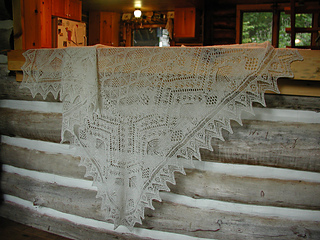patterns >  A Gathering of Lace and 1 more...
A Gathering of Lace and 1 more...
> Shetland Lace Shawl





Shetland Lace Shawl
Pattern Description from A Gathering of Lace: “This shawl, notably the border pattern, was inspired by one in the Victoria and Albert Museum, London. It was used at the christening of my grandson, Ross Walker, in May 1992. The construction is traditional: it is worked on a garter stitch ground without bound-off edges. The vandyked edging is worked widthwise for one side (Edging 1), stitches picked up along the inner edge for the border (Border 1), and the border worked towards the central square, decreasing every row. The central square is knit without breaking yarn. Three more sections of edging and border are worked and then sewn or grafted in place around the remaining sides of the central square.”
Skill Level: Experienced
Finished Measurements: 54” square
Yarn: Jamieson & Smith Cobweb-weight Shetland (½oz/14g; 225yds/205m; wool) 10 skeins White
Needles:
- Size 2 (2.75mm) needles, or size to obtain gauge
- Optional: Two size 2 (2.75mm) double-pointed needles (dpn) for edging
Extras:
- Stitch markers
- Waste yarn for cast-on
- 4 stitch holders or yarn for holding stitches
- For dressing: Powdered start or cornstarch, rust-proof T-pins or dressing frame, knitting cotton for lashing to frame.
Blocked Gauge: 32 sts and 48 rows to 4”/10cm in garter st using size 2 (2.75) needles
Notes:
- The additional pairs of 2-st rows in both the Border and the Edging charts provide necessary elasticity for the diagonal edges. Shetlanders call this “lengthening the edge.” This is most easily done by knitting (or purling - it makes no difference) the 2nd short row backwards to avoid turning the work.
- See Techniques, p. 162, for invisible cast-on and garter st grafting.
57 projects
stashed
63 times
- First published: November 2000
- Page created: July 16, 2007
- Last updated: May 21, 2018 …
- visits in the last 24 hours
- visitors right now




